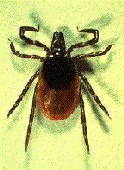
THURSDAY, April 22 (HealthDay News) — After more than a year of study, a specially appointed panel at the Infectious Diseases Society of America has decided that controversial guidelines for the treatment of Lyme disease are correct and need not be changed.
The guidelines, first adopted in 2006, have long advocated for the short-term (less than a month) antibiotic treatment of new infections of Lyme disease, which is caused by Borrelia burgdorferi, a bacteria transmitted to humans via tick bites.
However, the guidelines have also been the focus of fierce opposition from certain patient advocate groups that believe there is a debilitating, “chronic” form of Lyme disease requiring much longer therapy.
The IDSA guidelines are important because doctors and insurance companies often follow them when making treatment (and treatment reimbursement) decisions.
The new review was sparked by an investigation launched by Connecticut Attorney General Richard Blumenthal, whose office had concerns about the process used to draft the guidelines.
“This was the first challenge to any of the infectious disease guidelines” the Society has issued over the years, IDSA president Dr. Richard Whitley said during a press conference held Thursday.
Whitley noted that the special panel was put together with an independent medical ethicist, Dr. Howard Brody, from the University of Texas Medical Branch, who was approved by Blumenthal so that the committee would be sure to have no conflicts of interest.
The guidelines contain 69 recommendations, Dr. Carol J. Baker, chair of the Review Panel, and pediatric infectious diseases specialist at Baylor College of Medicine, said during the press conference.
“For each of these recommendations our review panel found that each was medically and scientifically justified in light of all the evidence and information and required no revision,” she said. For all but one of the votes the committee agreed unanimously, Baker added.
Particularly on the continued use of antibiotics, the panel had concerns that prolonged use of these drugs puts patients in danger of serious infection while not improving their condition, Baker said. “In the case of Lyme disease, there has yet to be a single high-quality clinical study that demonstrates comparable benefit to prolonging antibiotic therapy beyond one month,” the panel members found.
As to the existence of a chronic, persistent form of Lyme disease, the panel concluded that “symptoms that are commonly attributed to chronic or persistent Lyme, such as arthralgias, fatigue and cognitive dysfunction, are seen in many other clinical conditions and are, in fact, common in the general population. It would thus be clinically imprudent to make the diagnosis of Lyme disease using these nonspecific findings alone.”
Baker noted that so far there has been no comment from Attorney General Blumenthal on the panel’s decision.
“I think the attorney general was misguided by the [Lyme disease] activists,” Whitley said. “I do not think his contention against the Infectious Diseases Society was either justified or warranted,” he added.
Whitley noted that the Society will be reviewing these guidelines again in another two years and at the same time the U.S. Institute of Medicine is working on its own report on the disease.
However, the committee’s affirmation of the guidelines is seen by some to be a whitewash because, they claim, the review process was biased.
Dr. Robert Bransfield, president of the International Lyme and Associated Diseases Society, said: “How can there be such total consensus with any scientific issue? It’s beyond comprehension.”
Bransfield added, “It makes me wonder about the accuracy of the process. This is what everybody was expecting that they would do: a process that would rubber-stamp it and basically validate what was there before. It’s a concern because it does compromise the best interest of patients.”
Another critic, Dr. Raphael B. Stricker, a San Francisco physician who treats chronic Lyme disease, said that “when the panel votes eight-nothing on almost every single recommendation, that suggests that there is something wrong with the process.
“Until we get a really objective review by an objective panel that’s not all in Infectious Diseases Society of America’s pocket, you are going to get the kind of thing you see with this, and that’s a problem,” Stricker said.
On the other side of the issue, Phillip J. Baker, executive director of the American Lyme Disease Foundation, said he was pleased by the outcome.
“I have always felt, and so did many of my colleagues, that the guidelines are based on firm and established evidence,” Baker said.
Baker has sympathy for people suffering from the pain and fatigue associated with chronic Lyme disease.
“These people are suffering from something and no doubt they need proper medical care,” he said. “But they are not suffering from a persistent infection that can be treated by long-term antibiotic therapy. They have something serious that needs to be treated, but it’s not due to Lyme disease.”
More information
For more information on Lyme disease, visit the U.S. Centers for Disease Control and Prevention.

